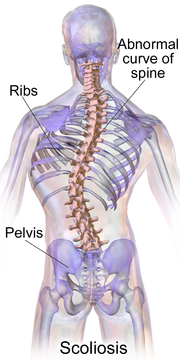Scoliosis
Spine postural abnormalities in which vertebral column has three diamentional curvature
Scoliosis is a medical condition in which the human or animal spine has a sideways curve. The curve is usually S-shaped or C-shaped.[7] In some, the curve is stable. In others, though, it increases over time.[8] Mild scoliosis does not often cause problems. Severe cases, however, can interfere with breathing and can cause pain.
| Scoliosis | |
|---|---|
 | |
| Pronunciation | |
| Medical specialty | Orthopedic surgery |
| Symptoms | Sideways curve in the back[2] |
| Usual onset | 10–20 years old[2] |
| Causes | Usually unknown[3] |
| Risk factors | Family history, cerebral palsy, Marfan syndrome, tumors such as neurofibromatosis[2] |
| Diagnostic method | X-ray[2] |
| Treatment | Watchful waiting, bracing, exercises, surgery[2][4] |
| Frequency | 3%[5][6] |
The cause of most cases is unknown. However, it is believed to involve a combination of genetic and environmental factors. Risk factors include having affected family members.
Diagnosis is often confirmed with x-rays.
Scoliosis usually occurs between ages 10 and 20. Males can be affected, although females are more often affected.
References
change- ↑ "Scoliosis". Merriam Webster. Archived from the original on 11 August 2016. Retrieved 12 August 2016.
- ↑ 2.0 2.1 2.2 2.3 2.4 Cite error: The named reference
NIH2015was used but no text was provided for refs named (see the help page). - ↑ Cite error: The named reference
GHR2013was used but no text was provided for refs named (see the help page). - ↑ Cite error: The named reference
Neg2018was used but no text was provided for refs named (see the help page). - ↑ Cite error: The named reference
Sh2014was used but no text was provided for refs named (see the help page). - ↑ "Scoliosis - Symptoms, Diagnosis and Treatment". aans.org. Retrieved 10 February 2022.
- ↑ "Scoliosis in Children and Adolescents". NIAMS. 7 April 2017. Retrieved September 27, 2019.
- ↑ "Adolescent Scoliosis". Genetic Home Reference. Retrieved September 27, 2019.